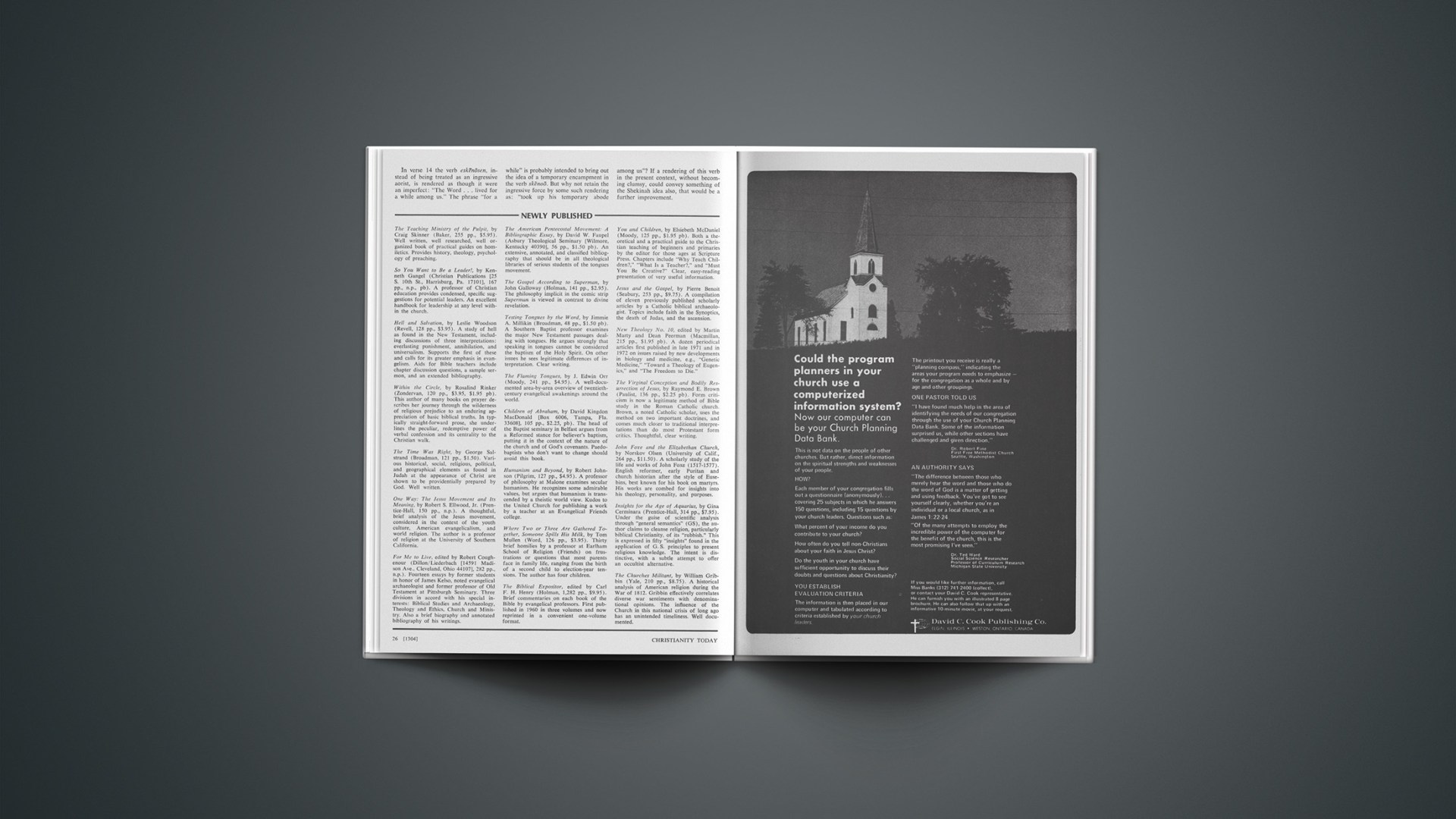The New International Version: The New Testament, (Zondervan, 1973, 640 pp., $5.95), is reviewed by F. F. Bruce, professor of biblical criticism, University of Manchester, Manchester, England.
This fall we greet the publication of the New Testament section of yet another major Bible translation, this one sponsored by the New York Bible Society. The enterprise was inaugurated in 1965 under the provisional title “A Contemporary Translation”; for some years those who knew about it referred to it as ACT. Now, no doubt, it will be called NIV (see editorials, page 41).
While most of the translators live in the United States, the work is international in that it draws upon the cooperation of scholars in many other parts of the English-speaking world: Great Britain, Ireland, Canada, New Zealand, and Australia. The work is also thoroughly transdenominational: all the main-line Protestant traditions, from Anglican and Presbyterian to Nazarene and Brethren, are represented both among the translators (who number nearly 100) and on the governing body of the enterprise, the Committee on Bible Translation, comprising fifteen well-known evangelical scholars.
The evangelical outlook of the scholars involved in the task of translation does not mean, of course, that there is anything sectarian about the product: if, as they say, “they hold their task to be a sacred trust to honor the Bible as the inspired Word of God,” that simply means that they undertake it (to borrow words from another context) “reverently, discreetly, advisedly, soberly, and in the fear of God.” The quality of Bible translation is enhanced, not diminished, when qualified scholars approach their work in that spirit; that was the spirit that characterized the original writers of the Bible.
On hearing of this new translation some readers will naturally ask, “Why yet another?” It is no part of the reviewer’s business to answer this question. The project was not conceived yesterday. Although, as has been said above, it was properly inaugurated in 1965, some of the participants had been discussing the idea for several years before that, and were manifestly convinced that there was room for a work of this kind. “But,” it might be asked again, “are there not three or four new evangelically sponsored versions of the Bible already in existence?” There are, to be sure—it would be invidious to mention names—but here is one that promises to be better than any of these. A review of the New International Bible might well conduct a comparative examination of this version alongside those others, but at present it will be best to consider it on its own.
First, then, it is (as the earlier provisional title put it) “a contemporary translation.” The English is idiomatic, of a kind that does not sound strange or archaic either in American or in British ears. Here is a straightforward paragraph of narrative and conversion to illustrate the point:
After this, Jesus and his disciples went out into the Judaean countryside, where he spent some time with them, and baptized. Now John also was baptizing at Aenon near Salim, because there was plenty of water, and people were constantly coming to be baptized. (This was before John was put in prison.) An argument developed between some of John’s disciples and a certain Jew over the matter of ceremonial washing. They came to John and said to him, “Rabbi, that man who was with you on the other side of the Jordan—the one about whom you testified—well, he is baptizing, and everyone is going to him.”
The resumptive “well” in the last sentence is a good idiomatic touch. We note that pronouns referring to our Lord (or indeed, to divine persons in general) remain uncapitalized. This is in keeping with traditional practice in Bible translation; changing it in some other recent translations has not been a wise policy. We note also that “you” replaces “thou” and “thee” in the singular; this is so not only when John is addressed (as in the extract quoted above) but also when Jesus or the heavenly Father is addressed. This too is a wise policy; otherwise translators have to try to decide (as did the translators of the RSV and NEB) when, for example, Jesus is being addressed “merely” as a man by people who have no clue about his divine nature and when he is being invoked as the Lord.
We note, further, that quotation marks are used; and their use calls here and there for interpretative discernment that the KJV and ARV translators did not need to exercise—not least in this chapter. John’s reply to his disciples, beginning in verse 27, goes on in this version to the end of verse 36; but perhaps the evangelist ended it at verse 30 and added his own meditation from verse 31 onwards. Similarly our Lord’s reply to Nicodemus’s last question goes on in this version (as in NEB) from verse 10 to verse 21, but a footnote mentions that “some interpreters end the quotation after verse 15”; in that case verses 16–21 would be the evangelist’s comment.
How a new version of the New Testament treats the prologue of John’s Gospel is always a matter of special interest. (John’s Gospel in this new version was published in advance of the New Testament as a whole, to serve as a preliminary sample.) Verse 1 is identical with KJV, which indeed can hardly be improved upon here. Verse 2 has a more natural word order: “He was with God in the beginning.” (I suspect, indeed, that the rather emphatic Greek pronoun used at the beginning of this verse implies more than this, but any such further implication could probably be brought out only in an expanded paraphrase, and that is not the category to which the New International Bible belongs.) The next point that calls for attention is that the punctuation between verses 3 and 4 follows the precedent of KJV and ARV, with a period at the end of verse 3: “… without him nothing was made that has been made.” This, I am sure, is right, despite the ancient attestation of the alternative punctuation. The alternative punctuation does not even rate a mention in the footnotes of this version.
In verse 5 the verb katelaben is translated “understood”; the footnote suggests the variant rendering “overpowered.” This no doubt represents a majority verdict; the reviewer would prefer an interchanging of the text and footnote renderings. “The darkness has not understood it” is just intelligible, but “the darkness has not overpowered it” is much more forceful. Verse 9 is properly translated: “The true light that gives light to every man was coming into the world.”
In verse 14 the verb eskēnōsen, instead of being treated as an ingressive aorist, is rendered as though it were an imperfect: “The Word … lived for a while among us.” The phrase “for a while” is probably intended to bring out the idea of a temporary encampment in the verb skēnoō. But why not retain the ingressive force by some such rendering as: “took up his temporary abode among us”? If a rendering of this verb in the present context, without becoming clumsy, could convey something of the Shekinah idea also, that would be a further improvement.
Newly Published
The Teaching Ministry of the Pulpit, by Craig Skinner (Baker, 255 pp., $5.95). Well written, well researched, well organized book of practical guides on homiletics. Provides history, theology, psychology of preaching.
So You Want to Be a Leader!, by Kenneth Gangel (Christian Publications [25 S. 10th St., Harrisburg, Pa. 17101], 167 pp., n.p., pb). A professor of Christian education provides condensed, specific suggestions for potential leaders. An excellent handbook for leadership at any level within the church.
Hell and Salvation, by Leslie Woodson (Revell, 128 pp., $3.95). A study of hell as found in the New Testament, including discussions of three interpretations: everlasting punishment, annihilation, and universalism. Supports the first of these and calls for its greater emphasis in evangelism. Aids for Bible teachers include chapter discussion questions, a sample sermon, and an extended bibliography.
Within the Circle, by Rosalind Rinker (Zondervan, 120 pp., $3.95, $1.95 pb). This author of many books on prayer describes her journey through the wilderness of religious prejudice to an enduring appreciation of basic biblical truths. In typically straight-forward prose, she underlines the peculiar, redemptive power of verbal confession and its centrality to the Christian walk.
The Time Was Right, by George Salstrand (Broadman, 121 pp., $1.50). Various historical, social, religious, political, and geographical elements as found in Judah at the appearance of Christ are shown to be providentially prepared by God. Well written.
One Way: The Jesus Movement and Its Meaning, by Robert S. Ellwood, Jr. (Prentice-Hall, 150 pp., n.p.). A thoughtful, brief analysis of the Jesus movement, considered in the context of the youth culture, American evangelicalism, and world religion. The author is a professor of religion at the University of Southern California.
For Me to Live, edited by Robert Coughenour (Dillon/Liederbach [14591 Madison Ave., Cleveland, Ohio 44107], 282 pp., n.p.). Fourteen essays by former students in honor of James Kelso, noted evangelical archaeologist and former professor of Old Testament at Pittsburgh Seminary. Three divisions in accord with his special interests: Biblical Studies and Archaeology, Theology and Ethics, Church and Ministry. Also a brief biography and annotated bibliography of his writings.
The American Pentecostal Movement: A Bibliographic Essay, by David W. Faupel (Asbury Theological Seminary [Wilmore, Kentucky 40390], 56 pp., $1.50 pb). An extensive, annotated, and classified bibliography that should be in all theological libraries of serious students of the tongues movement.
The Gospel According to Superman, by John Galloway (Holman, 141 pp., $2.95). The philosophy implicit in the comic strip Superman is viewed in contrast to divine revelation.
Testing Tongues by the Word, by Jimmie A. Millikin (Broadman, 48 pp., $1.50 pb). A Southern Baptist professor examines the major New Testament passages dealing with tongues. He argues strongly that speaking in tongues cannot be considered the baptism of the Holy Spirit. On other issues he sees legitimate differences of interpretation. Clear writing.
The Flaming Tongues, by J. Edwin Orr (Moody, 241 pp., $4.95). A well-documented area-by-area overview of twentieth-century evangelical awakenings around the world.
Children of Abraham, by David Kingdon MacDonald [Box 6006, Tampa, Fla. 33608], 105 pp., $2.25, pb). The head of the Baptist seminary in Belfast argues from a Reformed stance for believer’s baptism, putting it in the context of the nature of the church and of God’s covenants. Paedobaptists who don’t want to change should avoid this book.
Humanism and Beyond, by Robert Johnson (Pilgrim, 127 pp., $4.95). A professor of philosophy at Malone examines secular humanism. He recognizes some admirable values, but argues that humanism is transcended by a theistic world view. Kudos to the United Church for publishing a work by a teacher at an Evangelical Friends college.
Where Two or Three Are Gathered Together, Someone Spills His Milk, by Tom Mullen (Word, 126 pp., $3.95). Thirty brief homilies by a professor at Earlham School of Religion (Friends) on frustrations or questions that most parents face in family life, ranging from the birth of a second child to election-year tensions. The author has four children.
The Biblical Expositor, edited by Carl F. H. Henry (Holman, 1,282 pp., $9.95). Brief commentaries on each book of the Bible by evangelical professors. First published in 1960 in three volumes and now reprinted in a convenient one-volume format.
You and Children, by Elsiebeth McDaniel (Moody, 125 pp., $1.95 pb). Both a theoretical and a practical guide to the Christian teaching of beginners and primaries by the editor for those ages at Scripture Press. Chapters include “Why Teach Children?,” “What Is a Teacher?,” and “Must You Be Creative?” Clear, easy-reading presentation of very useful information.
Jesus and the Gospel, by Pierre Benoit (Seabury, 253 pp., $9.75). A compilation of eleven previously published scholarly articles by a Catholic biblical archaeologist. Topics include faith in the Synoptics, the death of Judas, and the ascension.
New Theology No. 10, edited by Martin Marty and Dean Peerman (Macmillan, 215 pp., $1.95 pb). A dozen periodical articles first published in late 1971 and in 1972 on issues raised by new developments in biology and medicine, e.g., “Genetic Medicine,” “Toward a Theology of Eugenics,” and “The Freedom to Die.”
The Virginal Conception and Bodily Resurrection of Jesus, by Raymond E. Brown (Paulist, 136 pp., $2.25 pb). Form criticism is now a legitimate method of Bible study in the Roman Catholic church. Brown, a noted Catholic scholar, uses the method on two important doctrines, and comes much closer to traditional interpretations than do most Protestant form critics. Thoughtful, clear writing.
John Foxe and the Elizabethan Church, by Norskov Olsen (University of Calif., 264 pp., $11.50). A scholarly study of the life and works of John Foxe (1517–1577). English reformer, early Puritan and church historian after the style of Eusebins, best known for his book on martyrs. His works are combed for insights into his theology, personality, and purposes.
Insights for the Age of Aquarius, by Gina Cerminara (Prentice-Hall, 314 pp., $7.95). Under the guise of scientific analysis through “general semantics” (GS), the author claims to cleanse religion, particularly biblical Christianity, of its “rubbish.” This is expressed in fifty “insights” found in the application of G. S. principles to present religious knowledge. The intent is distinctive, with a subtle attempt to offer an occultist alternative.
The Churches Militant, by William Gribbin (Yale, 210 pp., $8.75). A historical analysis of American religion during the War of 1812. Gribbin effectively correlates diverse war sentiments with denominational opinions. The influence of the Church in this national crisis of long ago has an unintended timeliness. Well documented.
There is no straining after novelty for novelty’s sake: where a traditional rendering is the most adequate, the translators have not devised another one just to be different. The Matthaean beatitudes begin: “Blessed are the poor in spirit, for theirs is the kingdom of heaven” (Matt. 5:3). If the desire is to translate the Greek, rather than to paraphrase or interpret it, it is difficult to see what other form of words could be used.
Similarly the Lord’s Prayer, contains no surprises. In the form given in Matthew 6:9–13, it runs:
Our Father in heaven,
hallowed be your name,
your kingdom come,
your will be done on earth as in heaven.
Give us today our daily bread.
Forgive us our debts, as we also have forgiven our debtors.
And lead us not into temptation,
but deliver us from the evil one.
Here is no attempt to tell the reader what is meant by being led into temptation—an attempt such as led the New English Bible translators into explaining the obscure by the more obscure. But a question mark may be put against the use of “debt” and “debtors.” It is generally agreed that this usage reflects the Aramaic use of the word for “debt” in the extended sense of “sin”; that being so, it would have been more intelligible (although less rhythmical) to render: “Forgive us our sins, as we also have forgiven those who have sinned against us.”
Let us look at the most crucial paragraph in the Pauline corpus. This is how Romans 3:21–26 is rendered:
But now a righteousness from God, apart from law, has been made known, to which the Law and the Prophets testify. This righteousness from God comes through faith in Jesus Christ to all who believe. There is no difference, for all have sinned and fall short of the glory of God, and are justified freely by his grace through the redemption that came by Christ Jesus. God presented him as a sacrifice of atonement, through faith in his blood. He did this to demonstrate his justice, because in his forbearance he had left the sins committed beforehand unpunished—he did it to demonstrate his justice at the present time, so as to be just and the one who justifies the man who has faith in Jesus.
We note that the same Greek word is translated “righteousness” in the first two sentences of the paragraph and “justice” in the last sentence. The change may be designed to show the close relation in the last sentence between the noun on the one hand and the adjective (“just”) and verb (“justifies”) on the other; it is nevertheless an awkward change. We note also that hilastérion is paraphrased “a sacrifice of atonement,” which comes very close to the sense of the passage. It is surprising, however, to see “in his blood” made dependent on “faith”—so surprising, indeed, that the reviewer, reflecting that he is working with a set of uncorrected proofs, wonders if a comma is to be supplied here.
Paul’s “saints” (KJV) are presented to us as “God’s people” (e.g., 1 Cor. 16:1). A man’s “virgin” (1 Cor. 7:36) is “the virgin he is engaged to.” This is probably right; the alternative interpretation (“his daughter”) is mentioned in a footnote.
Like the RSV and NEB, this version is based on an eclectic Greek text. In the present state of New Testament textual study, this was the wisest course. The incident of the adulterous woman (John 7:53–8:11) and the longer appendix to Mark (Mark 16:9–20) are printed in their traditional positions, but they are marked off from their contexts and a note indicates that they do not originally belong to the Gospels to which they are attached. The angel at Bethesda (John 5:4), the baptismal question and response of Philip and the eunuch (Acts 8:37), and the three heavenly witnesses (1 John 5:7) do not appear in the text but are mentioned in footnotes. The last-named is said to be added in the Vulgate, but it was absent from the original and authentic Vulgate text as well as from the Greek. In general, the Greek text reflected in the translation is one on which there would be today a consensus of critical agreement.
Measurements are sometimes modernized, sometimes not. Emmaus is “about seven miles” distant from Jerusalem (Luke 24:13), but the site of the ascension on the Mount of Olives is “a Sabbath day’s walk from the city” (a footnote explains that this is “about half a mile”). The flask of spikenard is reckoned as worth “a year’s wages” (John 12:5) or “more than a year’s wages” (Mark 14:5); Philip calculates that bread to feed the multitude in the wilderness would need at least “eight months’ wages” (John 6:7). But Matthew 25:14–30 tells “the parable of the talents” and Luke 19:11–27 tells “the parable of the ten minas”; Jesus’ questioners produce a “denarius” as a sample of the tribute money (Mark 12:15), the laborers in the vineyard agree to work for “a denarius for the day” (Matt. 20:2), and the two debtors in the parable of the unforgiving servant owe “ten thousand talents” and “a hundred denarii” (Matt. 18:24, 28). In all these latter instances footnotes give some indication of the value of the sums mentioned: thus the debts in Matthew 18:24, 28, are said to correspond to “several million dollars” and “a few dollars.”
The version, say the publishers, “is written in the language of the common man”; it never ceases to be dignified, but some renderings are more colloquial than others. Our Lord’s questioners in the tribute money incident say to him, “You aren’t swayed by men, because you pay no attention to who they are” (Mark 12:14), while Peter says to Simon Magus, “May your money perish with you, because you thought to buy the gift of God with money” (Acts 8:20). “You thought to buy” is literary, and none the worse for that, but as it comes in direct speech something a little more conversational might have been expected.
In fine, this new translation will be accepted widely. If there were not so many other translations of comparable quality in circulation, its acceptance would no doubt be wider still; the fact that it has so many rivals in the field is its misfortune, not its fault.
A Somewhat Gloomy Comforter
Hope in Time of Abandonment, by Jacques Ellul (Seabury, 306 pp., $8.95), is reviewed by Harold O. J. Brown, associate editor, Christianity Today.
Since he first began to attract the notice of the English-language reading public in the mid-1960s, Ellul—by using several publishers and bringing out translations of older works simultaneously with those of his most recent ones—has managed to deluge us with an astonishing number of volumes. His works fall into two categories: academic (historical, sociological) and spiritual. The historical and sociological works present problems, but no solutions; the spiritual ones offer hopeful answers, though even in them there is more than a suggestion that the present crisis is beyond us, and that all that the Christian can hope is to be a faithful, suffering witness in the midst of disorder.
According to Ellul, sociological and historical analysis of modern society leads to a hopeless blind alley. But, on the basis of what he calls Christian orthodoxy—still reminiscent of the neo-orthodoxy of Karl Barth—he knows that God does not send his revelation as the answer to our problems and questions. On the contrary, God sends revelation to call us away from our preoccupation with the things and concerns of the world to a completely different set of values. Hence the biblical message is not the answer to modern problems, in the sense that it does not address itself to the problems on the world’s agenda; but, paradoxically, in another, ultimately more important sense, it is the answer, since it addresses itself to man’s true needs, even though man may be unaware of them.










